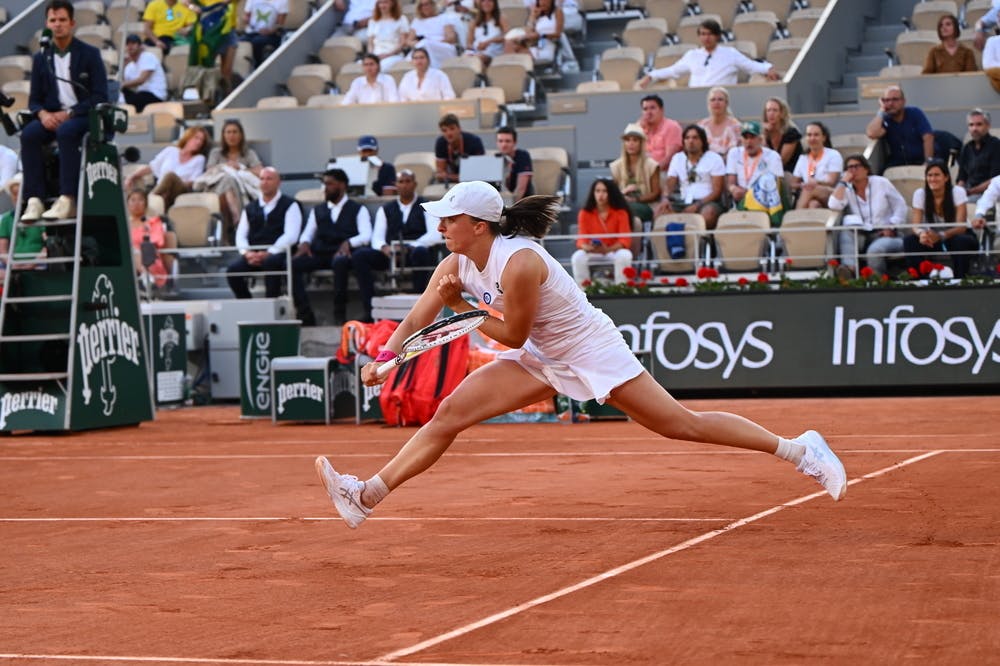To slide or not to slide? That is a serious question this week in Paris, where players play on courts covered by a centimetre of slippery crushed red brick top dressing.
Sliding is bliss on the terre battue
To slide or not to slide? Silly question really...
 ©Nicolas Gouhier / FFT
©Nicolas Gouhier / FFTAnd pretty much everybody says yes. Who could resist, after all? As it turns out, the ever evolving art of the slide is thriving these days.
“I think if you look at the modern game, I think almost every player now is able to slide on the right foot, the left foot, open stance, closed stance, seems like it gets better and better,” said Casper Ruud, two-time Roland-Garros runner-up.
Fans sitting courtside look on in admiration as players skate across the terre battue, leaving skid marks of ten metres and sometimes more. Those marks leave a trail of information, filling the blank canvas with footwork patterns anew after the courts are swept clean after every set.
“It's like an art form because you start the set, the court is clean, it's polished, no marks,” 2021 finalist Stefanos Tsitsipas said earlier this week. “You finish a set and you can see your entire movement on court, what you have done well and where you have positioned yourself on returns specifically.
"You can definitely learn a lot from that, use it as feedback.”
But not every player sees the clay as a canvas worthy of being hung in the Louvre. Some see it as a pain in the neck.
“Younger me absolutely hated sliding,” American Robin Montgomery told Rolandgarros.com. “You could try to tell me to do a sliding drill and I’d be in the back of the corner of the court, just standing there, saying ‘I’m not sliding.’”
 ©Clément Mahoudeau / FFT
©Clément Mahoudeau / FFTTsitsipas: 'It's like an art form.'
These days the 20-year-old, who picked up her first main draw win in Paris on her debut on Sunday, takes a more mature approach to the art.
“Now I believe it’s a useful tool to have, granted you don’t need to use it all the time,” she said. “Some can overuse it, and last year, when I shifted from hard to clay, I was sliding so much that it was messing up the timing of my shots because I was just using it too much. Now I grasp when to use it.
"I like sliding on clay, but I just use it at the right moments.”
American Tommy Paul says it is essential to be good at sliding.
“It's definitely an advantage to be able to move confidently and slide confidently,” the No.12 seed said. “I mean, there's times to slide and hit, and there's times to hit and slide. Being able to make those decisions in split seconds is very important.”
Not everybody embraces the art of sliding with open arms, however.
“Agassi didn’t slide, which was unheard of,” seven-time major champion John McEnroe told Rolandgarros.com during a conference call to promote TNT’s coverage of Roland-Garros.
 ©Philippe Montigny / FFT
©Philippe Montigny / FFTIga Swiatek is a natural mover on clay
But McEnroe says that Agassi, who completed the career golden Slam (winning all four majors and Olympic gold) by winning the title in Paris in 1999, is an exception rather than the rule.
“I don’t think there’s a player out there right now that doesn’t slide,” he said. “Obviously it’s a physical skill. The timing.
"Iga Swiatek, Jannik Sinner and Novak Djokovic are three of the best I’ve ever seen at timing their slide so that they can push off right when they stop the slide and hit the ball. That is a remarkable thing to do, and it’s very difficult to do.”
Some may struggle with it, and others can do it in their sleep. Either way, when it comes to the age-old question of to slide or not to slide, the answer is pretty simple this year in Paris.
“I feel like it's very hard to win on this surface if you don't move well,” says 2022 runner-up Coco Gauff. You know, you can, but I feel like it's hard to do.”
 ROLAND-GARROS
18 May - 7 June 2026
ROLAND-GARROS
18 May - 7 June 2026

